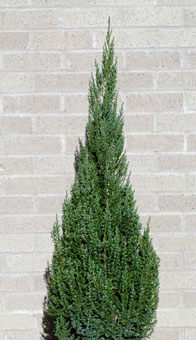|
Juniperus chinensis, 'Blue Point'
Common names: Chinese juniper, Blue Point Juniper Latin Name: Juniperus chinensis, 'Blue Point' Design Tip: A single specimen will create a prominent focal point. Or, several arranged symmetrically will add formality to a garden. When groomed into column form, the tall evergreen can be used as a cold-tolerant version of Italian cypress in Mediterranean designs. A densely spaced line planting will serve as a windbreak or privacy screening. Form: The tall upright shrub naturally grows narrow at the top and wider at the bottom, in a teardrop or conical shape. Dense branches of blue-green needles create a solid structure. Size: It can be maintained as an 8 to10 foot column, or it may reach a 12 to 15 foot height when left to grow without grooming. Annual expected growth rate is 12 to 18 inches. Soil: Chinese junipers accept both acidic and alkaline soils. They prosper in a moist well-drained site, yet are adaptable enough to serve xeriscape duty when well established. Light Exposure: Full sun is required to allow an equalized development. A too-close structure will cause slower development on one side and an encroaching plant will generate a slow die-off of branches where it meets the juniper. Hardiness: Heat tolerant and cold hardy in USDA Zones 4 to 9. Grooming: When left to grow in its natural shape, the branches will elongate beyond the central body. An annual trimming of protruding stems will keep a neat yet natural-like form. Twice-annual close trimmings will produce a clipped colonnade shape. Propagation: Semi-hardwood tipcuttings will root in 16-24 weeks during fall and winter with a misting system. Snippets: Besides the 'Blue Point' cultivar, there are dozens of Juniperius chinensis varieties available with a wider range of growth habits and foliage colors. Whether junipers are left to grow naturally, or clipped formally, the dense foliage provides shelter for birds in winter and cat-safe nesting lofts in spring and summer. |
Return to Plant Profiles Index Page
Cultivated, Photographed and written by
Maggie Ross McNeely in Fort Worth, Texas
All Rights Reserved
